Saturn S-Series
| Saturn S-Series | |
|---|---|
|
| |
| Overview | |
| Manufacturer | Saturn (General Motors) |
| Production | 1991–2002 |
| Assembly | United States: Spring Hill, Tennessee (Spring Hill Manufacturing) |
| Body and chassis | |
| Class | Compact car |
| Layout | Transverse front-engine, front-wheel drive |
| Platform | GM Z platform |
| Chronology | |
| Successor | Saturn Ion |
The Saturn S-Series are a family of compact cars from the Saturn automobile company. This was the first series of Saturn vehicles. The automobile platform, the Z-body, was developed entirely in-house at Saturn and shared very little with the rest of the General Motors model line. It implemented a spaceframe design, also seen on some Pontiacs, which meant that the side panels did not carry load and could use plastic pieces instead of metal. These polymer panels were dent-resistant—something that remained a selling point for Saturn until the brand's demise. The S-series was sold from the fall of 1991 through the end of the 2002 model year, with partial redesigns in 1996 & 2000 (sedans) and 1997 & 2001 (coupes).
The S-series debuted with SL (“sedan level”) models in 1991 for the 1992 model year, a 2-door sports coupe designated SC joined for the 1992 model year and the SW (“sedan wagon”) joined the lineup for 1993.
Taiwan and Japan were the only two Asian countries to import Saturns. From 1992 to 1996, the first- and second-generation sedans plus the first-generation coupes were sold in Taiwan. From 1996 to 2003, the second-generation versions were sold in right-hand drive in Japan, and some Toyota Netz dealerships, and former Isuzu dealerships did offer Saturn products until 2001. The first generation vehicles were not in compliance with Japanese Government regulations concerning exterior dimensions and maximum engine displacement requirements, while the second and third generation sedan and wagon were, however, the coupe was not for all generations.
Canada imported all available Saturn models from 1992 onwards.
A change partway through the 1999 model year gave the SC a small suicide door on the driver's side. This type of door had previously been used in extended cab pickup trucks, but was an innovation in coupe design.[1]
The S-series was replaced by the larger Saturn Ion in 2003, which was unable to match the S-series' sales numbers before the end of its own production at the end of 2007.
Coupes and sedans equipped with the base single overhead cam engine and a manual transmission were among the most fuel-efficient cars available in the United States when they were produced, reaching 40 miles per US gallon (5.9 L/100 km; 48 mpg-imp) in EPA highway tests at the time (this would likely translate to 36 miles per US gallon (6.5 L/100 km; 43 mpg-imp) under current methodologies).[2]
First generation
| First generation | |
|---|---|
 | |
| Overview | |
| Also called |
Saturn SL Saturn SW Saturn SC |
| Production |
1991–1995 SL 1993–1995 SW 1991–1996 SC |
| Body and chassis | |
| Body style |
2-door coupe 4-door sedan 5-door station wagon |
| Powertrain | |
| Engine |
1.9 L LK0 I4 (Gasoline) 1.9 L L24 I4 (Gasoline) 1.9 L LL0 I4 (Gasoline) |
| Transmission |
4-speed Saturn MP6 automatic 4-speed Saturn MP7 automatic 5-speed Saturn MP2 manual 5-speed Saturn MP3 manual |
| Dimensions | |
| Wheelbase |
SL & SW: 102.4 in (2,601 mm) SC: 99.2 in (2,520 mm) |
| Length |
SL & SW: 176.3 in (4,478 mm) 1991–93 SC: 175.8 in (4,465 mm) 1994–96 SC1: 173.2 in (4,399 mm) 1994–96 SC2: 174.6 in (4,435 mm) |
| Width | 67.6 in (1,717 mm) |
| Height |
SC: 50.6 in (1,285 mm) SL: 52.5 in (1,334 mm) SW: 53.7 in (1,364 mm) |
| Curb weight |
SC: 2,293.9–2,416.7 lb (1,040–1,096 kg) SL: 2,320.5–2,456.5 lb (1,053–1,114 kg) SW: 2,397.3–2,499.4 lb (1,087–1,134 kg) |
First generation SL and SW
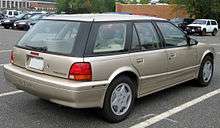
The first generation SL and SW were constructed from model year 1991 to 1995. The first Saturn to leave the assembly line in the Spring Hill, Tennessee factory was on July 30, 1990, the same day that then-CEO of GM, Roger Bonham Smith, retired. It was maroon with a tan interior.
Originally there were two available trim levels. The SL1 trim level featured a SOHC 1.9 L I4 LK0 engine that was rated at 85 hp (63 kW), which was rated at 27 mpg-US (8.7 L/100 km; 32 mpg-imp) city, 37 mpg-US (6.4 L/100 km; 44 mpg-imp) Highway. The SL2 trim level featured a DOHC 1.9 L I4 LL0 engine that was rated at 124 hp (92 kW), 24 mpg-US (9.8 L/100 km; 29 mpg-imp) city, 34 mpg-US (6.9 L/100 km; 41 mpg-imp) Highway.
1991–1992 model year Saturns featured the base "SL" available with a manual transmission only, an "SL1", "SL2", and "SC".
For model year 1993, the line expanded to include the SW1 and SW2 wagons, which were mechanically identical to their SL1 and SL2 counterparts. All models received an interior redesign for 1995 with a new dashboard and dual airbags. All S-Series cars were offered with either a 5-speed manual transmission or a 4-speed automatic transmission. The automatic featured a performance setting which gave crisper shifts at a higher RPM, and a setting for traction in which the transmission would stay in 2nd gear from a stop for more controlled take-offs. The Saturn transmissions in the DOHC-equipped vehicles were geared to enhance acceleration, while the SOHC-equipped model transmissions were geared toward economy.
The base SL1 engine was upgraded to the 100 hp (70 kW) L24 engine for the 1995 model year. The two base engines were mechanically identical, save for the upgrade from TBI to non-sequential MPFI. The 100HP engine also featured improved fuel economy of 26 mpg-US (9.0 L/100 km; 31 mpg-imp) city, 40 mpg-US (5.9 L/100 km; 48 mpg-imp) Highway
The S-Series had a 12.8 US gallons (48 L; 11 imp gal) fuel tank, which means that both cars got around 384 miles (618 km) on a single tank based on average of 32 mpg-US (7.4 L/100 km; 38 mpg-imp). Owners of the base model typically report real-world fuel mileage of about 38–41 mpg-US (6.2–5.7 L/100 km; 46–49 mpg-imp) on the highway with the manual transmission.
First generation SC
The first generation SC was made from model year 1991 to 1996. Originally only one trim level, SC, was available, with a DOHC 1.9 L I4 LL0 engine that was rated at 124 hp (92 kW). For 1993, the original SC trim level was renamed SC2, and an SC1 trim level was introduced. For 1994, the SC1/SC2 got revised power door locks and a recalibrated automatic transmission. The first generation SC2 received a minor refresh for 1995 in which the lower front bumper, and taillights were redesigned, and the interior got a new dashboard with dual airbags.
The SC1 featured an SOHC 1.9 L I4 LK0 engine that rated at 85 hp (63 kW). The SC1 engine was later upgraded to the 100 hp (70 kW) L24 engine for the 1995 model year. The first generation SC1 shared its front fascia with the SL and SW rather than the SC2, and also lacked a trunk lid reflector and a rear stabilizer bar.
- 1991-1995 Saturn SC/SC2
 1995-1996 Saturn SC2
1995-1996 Saturn SC2- Saturn SC1
Second generation
| Second generation | |
|---|---|
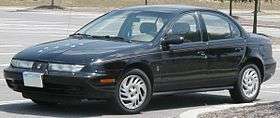 | |
| Overview | |
| Also called |
Saturn SL1 Saturn SL2 Saturn SW1 Saturn SW2 Saturn SC1 Saturn SC2 |
| Production |
1996–1999 SL 1996–1999 SW 1997–1999 SC |
| Body and chassis | |
| Body style |
2-door coupe (1997–1998) 3-door coupe (1999-2002) 4-door sedan 5-door station wagon |
| Powertrain | |
| Engine |
1.9 L L24 I4(Gasoline) 1.9 L LL0 I4(Gasoline) |
| Transmission |
4-speed Saturn MP6 automatic 4-speed Saturn MP7 automatic 5-speed Saturn MP2 manual 5-speed Saturn MP3 manual |
| Dimensions | |
| Wheelbase | 102.4 in (2,601 mm) |
| Length |
1996–99 SW & 1996–97 SL: 176.8 in (4,491 mm) 1998–99 SL: 176.9 in (4,493 mm) |
| Width |
1996–99 SW: 66.7 in (1,694 mm) 1997–2000 SC: 67.3 in (1,709 mm) 1996–99 SL: 66.7 in (1,694 mm) |
| Height | 1996–99 SW & SL: 54.5 in (1,384 mm) |
Second generation SL and SW
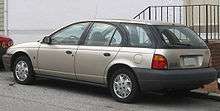
The second generation SL and SW were made from model year 1996 to 1999. The redesign resulted in a more curvaceous look for the SL/SW, which gave a slight increase in interior room and doorway size as well as an updated appearance. Mechanically, very little was changed from the previous model. The biggest changes for 1996 were the OBDII PCM, an all new sequential fuel injection setup that utilized a first ever "compress sense" cam sensor setup (cam sensor input was achieved by the ignition module sensing the amount of amperage it took to fire cylinder number 4. More amperage meant TDC compression, less meant TDC exhaust) in lieu of a conventional camshaft position sensor. Also full spark control (timing and firing of the ignition coils) was achieved solely in the engine control module as opposed to the ignition module.
A few minor changes were made in the mid-1998 model year. Due to multiple complaints of noise from the trip odometer on the 1995-early '98 gauge cluster, a new cluster with a digital odometer was introduced, rear disc brakes were deleted as an option due to high cost and very little improvement in braking performance over the conventional rear drum setup, the performance/normal mode switch was deleted from the transmission in lieu of new ECU software that learned the driving patterns of the operator and adjusted shift patterns accordingly, and a new larger muffler was introduced to reduce engine exhaust NVH levels.
Models made late in the 1999 model year (sometimes referred to as "1999.5" models) received improvements to both SOHC and DOHC engines that did not affect power output, but did smooth out some of the harshness and tendencies toward oil consumption associated with them. These changes included revised pistons (SOHC engines now used the same (flat top) pistons as the DOHC engines instead of the old dished pistons), connecting rods, crankshaft counterweights and the now narrower twin cam cylinder head featured a new roller rocker setup with hydraulic tappets and roller cams replacing the conventional bucket lifter setup of the previous engine. Fuel economy of these refined models also saw a measurable improvement. Also introduced in 1999 for vehicles equipped with California emissions, was a different exhaust manifold that housed an upstream catalytic converter (this converter heated up much faster than the conventional unit and decreased exhaust emissions faster) and provisions for an air injection reaction system (this injected fresh air into the exhaust to reduce hydrocarbons at start up, and help the oxygen sensors and catalytic converters reach operating temperatures faster). These vehicles were made to meet the all new CARB ULEV standards for the 1999 model year. These changes, among others, were subtly introducing the differences of the third generation S-series.
Second generation SC

The second generation SC was made from model year 1997 to late 1999. The second generation SC also moved to the longer wheelbase of the SL/SW models, resulting in an equal wheelbase across all models. The redesign resulted in a more curved look for the SC, which gave a slight increase in interior room and doorway size as well as an updated appearance. Mechanically for 2000, the coupes also saw the introduction of the plastic intake manifold. For the 1999 model year, a small rear-hinged third door was added to the driver's side. Although the third door allows passengers to enter and exit the rear seat without sliding the driver's seat forward, it was intended to provide easier access to the rear seat for parcels as the door's latch is on its front edge, and is thus inaccessible unless the front door is open. This prohibits a user from opening (or closing) the rear door if the front door is not open. The SC1 also lacked a rear sway bar.[1]
Third generation
| Third generation | |
|---|---|
|
| |
| Overview | |
| Also called |
Saturn SL1 Saturn SL2 Saturn SW1 Saturn SW2 Saturn SC1 Saturn SC2 |
| Production |
2000-2002 SL 2000-2002 SW 2000-2002 SC |
| Body and chassis | |
| Body style |
3-door coupe 4-door sedan 5-door station wagon |
| Powertrain | |
| Engine |
1.9 L L24 I4(Gasoline) 1.9 L LL0 I4(Gasoline) |
| Transmission |
4-speed Saturn MP6 automatic 4-speed Saturn MP7 automatic 5-speed Saturn MP2 manual 5-speed Saturn MP3 manual |
| Dimensions | |
| Wheelbase | 102.4 in (2,601 mm) |
| Length |
2000–02 SL & SW: 178.1 in (4,524 mm) 2001–02 SC: 180.5 in (4,585 mm) |
| Width |
2000–01 SW: 66.4 in (1,687 mm) 2001–02 SC: 68.2 in (1,732 mm) 2000–02 SL: 66.4 in (1,687 mm) |
| Height |
2000–01 SW: 55.6 in (1,412 mm) 2000–02 SL: 55 in (1,397 mm) 2001–02 SC: 53 in (1,346 mm) |
Third generation SL and SW

In 2000, the second generation was facelifted for the final time before the S-Series was discontinued in 2002. This became known as the third generation of the S-Series.[3]
The third generation featured many style changes to the exterior and interior, as well as some mechanical and electronic differences. The interior was completely redesigned, featuring a completely different dashboard design from previous generations. This new dash featured an electronic odometer, which did not break like the first generation's mechanical odometer. The 3rd generation was also the only S-Series to use a standard sized Double DIN stereo.
The third generation also used a refreshed design seat set for the interior as well for the SL2, SW2, and SC2 models. These seats have more padding than previous years. The SL1, SW1, and SC1 seats remained the same for the base models of the car.
In addition to the engine changes at the end of the 2nd generation, the original aluminum intake manifold was replaced by a plastic intake.
The third generation also was the first Saturn to make use of a Body Control Module (BCM), and a Powertrain Control Module (PCM) in tandem with each other. The BCM controlled all interior functions, as well as gauge functions, illumination of the dash equipment, mileage displayed on the odometer, and other functions. This allowed the PCM to be relocated under the hood of the car behind the battery. In the 3rd Generation, the PCM is strictly for controlling the transmission and engine of the vehicle. It has no control over any other function besides the running and emissions control of the car. The wiring harness was changed in several areas on the interior and inside the engine compartment, presumably to allow the relocation of the PCM and the addition of a BCM.
Third generation SC
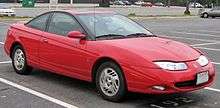
The third generation of Saturn SC maintained the familiar SC1 and SC2 monikers. They were essentially identical to the second generation SC in all terms except appearance where minor updates were done to improve the lines[4] and a PCM and BCM were added. For the final generation a special suite of options called the Saturn Expression Series was introduced.[5] These options included a HKS intake and exhaust, American Racing Wheels 15 inch alloys, GT Styling ground effects and rear spoiler, and Progress Group suspension springs.[6]
Special edition Saturns
A special Homecoming edition of the SL2 was released for 1994. It had special Pearl White paint (a "silver-tint" pearl, shared with Cadillac models of this year), black Saturn emblems, spoiler, 15-inch (380 mm) "teardrop" wheels, anti-lock four-wheel disc brakes, grey leather/cloth interior, rear headrests, fog lamps, and power locks and windows. Options included a sunroof, CD player, and the 4-speed automatic with traction control.
In 1998 and 1999, prospective buyers of a red or white SC2 had the option of purchasing the "Black Top Coupe Package" for $225.00 (US). The models were referred to as the "Red Hot Coupe" or "White Hot Coupe", based on the exterior color. The package came with a black roof panel, black outside rear view mirrors, black emblems, white face gauges and black accented teardrop wheels. These are extremely rare.
In 1999, a second Homecoming Edition was produced in a special "Mint Color" with tan leather interior, special off-white gauge faceplates, and black Saturn badges to commemorate the second "Homecoming" visit to the Spring Hill, Tennessee manufacturing facility. The 1999 Homecoming Edition also had the same features offered as the 1994 Homecoming Edition.
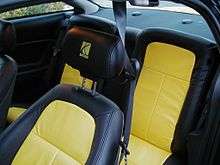
In 2001, a special yellow SC2 coupé model was also built. The model was officially named "Limited Edition", but soon became known as the "Bumblebee Edition". 99 were produced, each with a certificate of authenticity. The "Bumblebee Edition" included embroidered headrests, black leather interior with yellow leather inserts on the seats and door panels, black roof and mirrors, number designation inside fuel filler door and certificate of authenticity. These are not to be confused with the regular issue Yellow Sport Coupe.
2001 also saw a "10th Anniversary Edition" (also known as the "Silver Anniversary Edition") SL sedan model. 1,000 of these vehicles were made; all in SL2 trim with "SILVER" finish. The car commemorated the 10th anniversary of the Saturn SL's production. Included features were black perforated leather interior with silver stitching, embroidered Saturn 10th Anniversary" head rests, unique black (with pearl brite perimeter finish) Saturn badges, silver faced gauge cluster, rear spoiler and restyled 15" premium alloy "Teardrop II" wheels with silver painted inlays. Options included ABS, side curtain airbags, sunroof, driving lights and embroidered "Saturn 10th Anniversary" floor mats.
Another Limited SL for 2001 was the "Bright Red" sedan. Approximately 664 were built.
| 1994 Homecoming Edition | ~3,500 |
| 1998 White Hot Coupe | 213 |
| 1998 Red Hot Coupe | 657 |
| 1999 White Hot Coupe | 285 |
| 1999 Red Hot Coupe | 284 |
| 1999 Homecoming Edition | 4,000 |
| 2001 Limited Edition SC2 | 99 |
| 2001 10th Anniversary Edition | 1,000 |
| 2001 Bright Red | 664 |
Right hand drive
In addition to the above-mentioned "Special Edition" Saturns; there was also the 1999 – 2001 Saturn SWP "Postal" Station Wagon that were produced (450 in 1999), intended to be marketed to rural route mail carriers. These station wagons were right hand drive vehicles.
There were also a limited number of Saturns that were exported to Japan as right hand drive vehicles circa between 1997 and 2000. Aside from having the steering wheel on the other side, Japanese market Saturns were also fitted with slightly different light units. The rear lamps had amber turn signals and the front indicators were mounted closer to the corners rather than inboard.
The Saturn faced a hard time in Japan, where it played directly into the strengths of the Japanese manufacturers, comparing unfavorably with better-priced and more competent Japanese compact cars.[7] The interior, especially, received criticism.[8] A mere 602 units were sold in Saturn's first year in Japan (April to December 1997).[9]
Another problem was that Japanese car dealers have always excelled at customer service; this meant that Saturn's main sales argument in the United States was meaningless in the Japanese market.[10] The introduction of Saturn was also ill timed, as the economy was in the midst of a recession due to the effects of the 1980s "bubble economy". As the Japanese had less money to spend on "luxury goods", as imported products are regarded, Saturn found very few buyers.
Theft
The 1995 Saturn SL was the most stolen vehicle in 2003, while the 1994 SL took third place in CCC Information Services's 2003 most stolen vehicle report.[11] According to the Lynnwood, Washington police department, when use of the key wears on the door and ignition mechanisms, a filed blank key can be used to open the door and start the engine.
Racing
Saturn SC's competed in the SCCA World Challenge in the 1990s, winning several races from 1995–1997.[12][13][14] Several S-series cars have been used as rally race cars.
Safety
Insurance Institute for Highway Safety (IIHS)
| Moderate overlap frontal offset | Acceptable |
| Small overlap frontal offset | Not Tested |
| Side impact | Not Tested |
| Roof strength | Not Tested |
NHTSA
| Year | Frontal Driver | Frontal Passenger | Side Driver | Side Passenger | 4x2 Rollover |
|---|---|---|---|---|---|
| 1991 | |
|
Not Rated | Not Rated | Not Rated |
| 1992 | |
|
Not Rated | Not Rated | Not Rated |
| 1993 | |
|
Not Rated | Not Rated | Not Rated |
| 1994 | |
|
Not Rated | Not Rated | Not Rated |
| 1995 | |
|
Not Rated | Not Rated | Not Rated |
| 1996 | |
|
Not Rated | Not Rated | Not Rated |
| 1997 | |
|
|
|
Not Rated |
| 1998 | |
|
|
|
Not Rated |
| 1999 | |
|
|
|
Not Rated |
| 2000 | |
|
|
|
Not Rated |
| 2001 | |
|
|
|
|
| 2002 | |
|
|
|
|
Production numbers
Listed below is a rough estimate on the numbers of S-Series produced from 1991–2002.[28]
| Year | Coupe | Sedan | Wagon | Total | ||||||||
|---|---|---|---|---|---|---|---|---|---|---|---|---|
| SC | SC1 | SC2 | Total | SL | SL1 | SL2 | Total | SW1 | SW2 | Total | ||
| 1991 | ~10,000 | - | - | ~10,000 | ~38,629 | - | - | - | ~48,629 | |||
| 1992 | - | - | - | - | - | 169,959 | ||||||
| 1993 | - | 244,621 | ||||||||||
| 1994 | - | 267,518 | ||||||||||
| 1995 | - | 62,434 | 221,102 | 19,452 | 302,988 | |||||||
| 1996 | - | 294,198 | ||||||||||
| 1997 | - | 70,711 | 213,182 | 31,099 | 314,992 | |||||||
| 1998 | - | 38,591 | 160,759 | 20,415 | 219,765 | |||||||
| 1999 | - | 52,965 | 203,578 | 19,090 | 275,633 | |||||||
| 2000 | - | 8,517 | 8,724 | 17,241 | 68,907 | 142,992 | 9,633 | 169,866 | ||||
| 2001 | - | 23,584 | 17,414 | 40,998 | 73,428 | 3,416 | 117,842 | |||||
| 2002 | - | - | - | - | ||||||||
References
- 1 2 "BEHIND THE WHEEL/Saturn SC2; Finding a Jackpot Behind Door No. 3". nytimes.com. 1999. Retrieved 2012-07-30.
- ↑ "Compare Old and New EPA MPG Estimates: 1997 Saturn SL". United States Environmental Protection Agency. Retrieved January 27, 2010.
- ↑ "Time to Fix the Lack of a 3rd-Gen Section on Wikipedia.org - SaturnFans.com Forums". Saturnfans.com. Retrieved 2015-02-23.
- ↑ unknown. "2002 Saturn SC". cars.com. Retrieved 7 April 2014.
- ↑ "New Saturn Expression Series Accessories Make It Easy To Personalize Saturn Coupe". guideauto.com. Guide Auto. Retrieved 2014-04-07.
- ↑ "Saturn photograph" (JPG). Autointell.com. Retrieved 23 February 2015.
- ↑ Latham, Scott (1998-05-13), Grinding Gears: The Japanese Auto Dealer Network and American Trade Copmplaints (PDF), Chester Springs, PA: Scott Latham Associates, p. 60
- ↑ Latham, p. 64
- ↑ Latham, p. 59
- ↑ Latham, p. 62
- ↑ "1995 Saturn SL Tops Most Stolen Vehicle List". saturnfans.com/. Retrieved 2008-04-03.
- ↑ "1995 World Challenge : Round 1" (PDF). Scca.cdn.racersites.com. Retrieved 23 February 2015.
- ↑ "1996 World Challenge" (PDF). Scca.cdn.racersites.com. Retrieved 23 February 2015.
- ↑ "SCCA Pro Racing Results : 1997 World Challenge Touring 1 Class" (PDF). Scca.cdn.racersites.com. Retrieved 2013-10-13.
- ↑ "IIHS-HLDI: Saturn SL". Iihs.org. Retrieved 2013-03-22.
- ↑ "1991 Saturn SL 4-DR. | Safercar – NHTSA". Safercar.gov. Retrieved 2013-03-22.
- ↑ "1992 Saturn SL 4-DR. | Safercar – NHTSA". Safercar.gov. Retrieved 2013-03-22.
- ↑ "1993 Saturn SL 4-DR. | Safercar – NHTSA". Safercar.gov. Retrieved 2013-03-22.
- ↑ "1994 Saturn SL 4-DR. | Safercar – NHTSA". Safercar.gov. Retrieved 2013-03-22.
- ↑ "1995 Saturn SL 4-DR. | Safercar – NHTSA". Safercar.gov. Retrieved 2013-03-22.
- ↑ "1996 Saturn SL 4-DR. | Safercar – NHTSA". Safercar.gov. Retrieved 2013-03-22.
- ↑ "1997 Saturn SL 4-DR. | Safercar – NHTSA". Safercar.gov. Retrieved 2013-03-22.
- ↑ "1998 Saturn SL 4-DR. | Safercar – NHTSA". Safercar.gov. Retrieved 2013-03-22.
- ↑ "1999 Saturn SL 4-DR. | Safercar – NHTSA". Safercar.gov. Retrieved 2013-03-22.
- ↑ "2000 Saturn SL 4-DR. | Safercar – NHTSA". Safercar.gov. Retrieved 2013-03-22.
- ↑ "2001 Saturn SL 4-DR. | Safercar – NHTSA". Safercar.gov. Retrieved 2013-03-22.
- ↑ "2002 Saturn SL 4-DR. | Safercar – NHTSA". Safercar.gov. Retrieved 2013-03-22.
- ↑ Auto Editors of Consumer Guide (2002). The Encyclopedia of American Cars. Publications International.
| Wikimedia Commons has media related to Saturn S-Series. |
| Saturn automobile timeline, 1991–2010 | ||||||||||||||||||||||||||||||||||
|---|---|---|---|---|---|---|---|---|---|---|---|---|---|---|---|---|---|---|---|---|---|---|---|---|---|---|---|---|---|---|---|---|---|---|
| Type | 1990s | 2000s | 2010s | |||||||||||||||||||||||||||||||
| 1 | 2 | 3 | 4 | 5 | 6 | 7 | 8 | 9 | 0 | 1 | 2 | 3 | 4 | 5 | 6 | 7 | 8 | 9 | 0 | |||||||||||||||
| Sports car | EV1 | Sky | ||||||||||||||||||||||||||||||||
| Compact car | S-Series | S-Series | S-Series | Ion | Astra | |||||||||||||||||||||||||||||
| Mid-size car | L-Series | Aura | ||||||||||||||||||||||||||||||||
| Compact crossover utility vehicle | Vue | Vue | ||||||||||||||||||||||||||||||||
| Full-size crossover utility vehicle | Outlook | |||||||||||||||||||||||||||||||||
| Minivan | Relay | |||||||||||||||||||||||||||||||||
| Vehicle leased under General Motors brand | ||||||||||||||||||||||||||||||||||